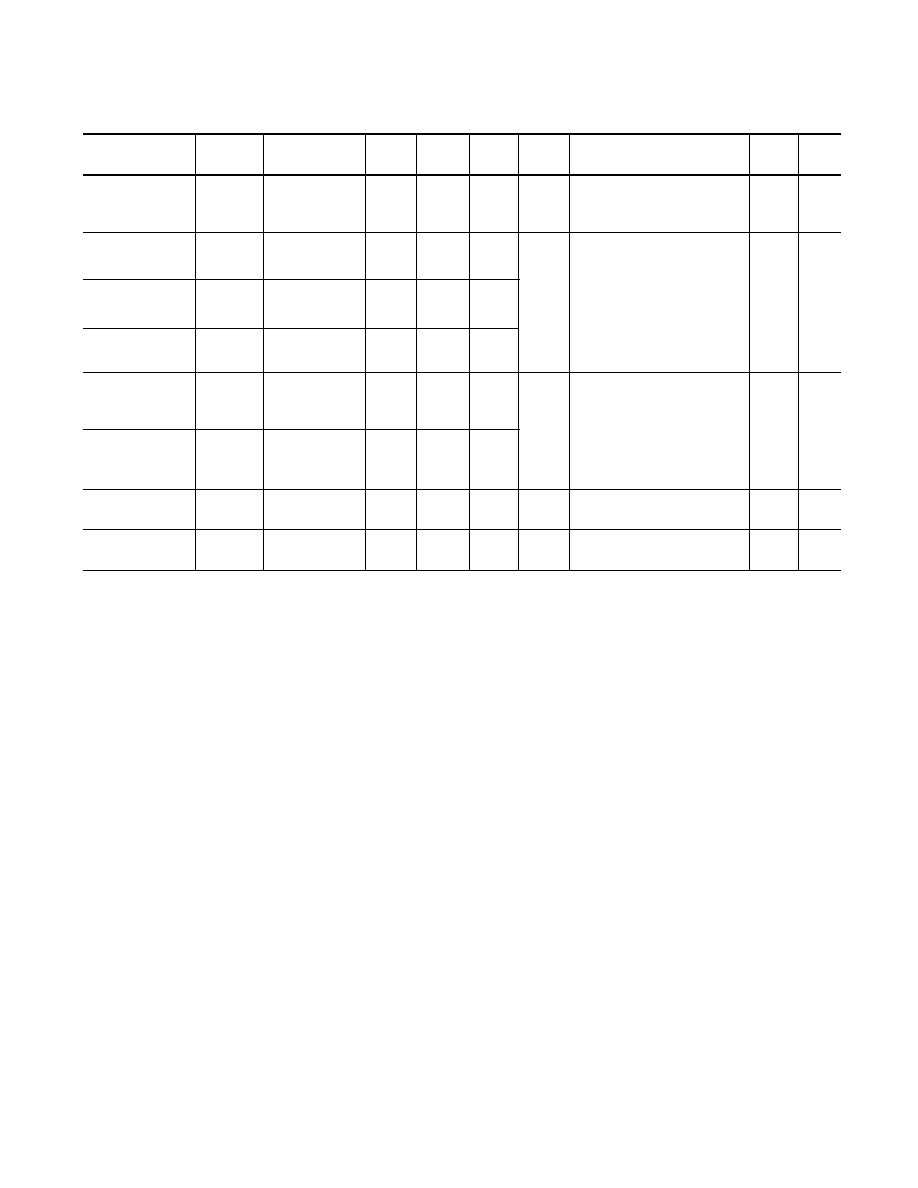- 您現(xiàn)在的位置:買賣IC網(wǎng) > PDF目錄68799 > 5962-9755701HPA ISOLATION AMPLIFIER, 100 kHz BAND WIDTH, CDIP8 PDF資料下載
參數(shù)資料
| 型號(hào): | 5962-9755701HPA |
| 元件分類: | 隔離放大器 |
| 英文描述: | ISOLATION AMPLIFIER, 100 kHz BAND WIDTH, CDIP8 |
| 封裝: | HERMETIC SEALED, DIP-8 |
| 文件頁(yè)數(shù): | 13/16頁(yè) |
| 文件大?。?/td> | 105K |
| 代理商: | 5962-9755701HPA |
第1頁(yè)第2頁(yè)第3頁(yè)第4頁(yè)第5頁(yè)第6頁(yè)第7頁(yè)第8頁(yè)第9頁(yè)第10頁(yè)第11頁(yè)第12頁(yè)當(dāng)前第13頁(yè)第14頁(yè)第15頁(yè)第16頁(yè)

6
AC Electrical Specifications
Over recommended operating conditions (TA = –55C to +125C, VIN+ = 0 V, VIN– = 0 V, VDD1 = 5 V and
VDD2 = 5 V, unless otherwise specified).
Group A[12]
Parameter
Symbol
Subgroups
Min.
Typ.*
Max. Units
Test Conditions
Fig.
Note
Common Mode
CMR
9
5
8
kV/
sVCM = 1 kV
16
8,13
Rejection
4.5 V
≤ (VDD1, VDD2)
≤ 5.5 V, TA = 25C
Propagation
tPD50
9,10,11
3.7
7.5
sVIN+ = 0 to 100 mV step
18,19
Delay to 50%
4.5 V
≤ (VDD1, VDD2)
≤ 5.5 V
Propagation
tPD90
9,10,11
5.7
11.0
Delay to 90%
Rise/Fall
tR/F
9,10,11
3.4
7.5
Time (10-90%)
Small-Signal
f–3 dB
9,10,11
45
100
kHz
4.5 V
≤ (VDD1, VDD2)
18,20, 14
Bandwidth
≤ 5.5 V
21
(–3 dB)
VIN+ = 200 mVpk-pk
Small-Signal
f–45
31
Bandwidth
(–45)
RMS Input-
VN
0.6
mVrms
In recommended
22,24
9
Referred Noise
application circuit
Power Supply
PSR
570
mVP–P
10
Rejection
*All typicals are at the nominal operating conditions of VIN+ = 0 V, VIN– = 0 V, TA = 25C, VDD1 = 5 V and VDD2 = 5 V.
Notes:
1. If VIN– is brought above VDD1 –2 V with respect to GND1 an internal test mode may be activated. This test mode is not intended for customer use.
2. Exact offset value is dependent on layout of external bypass capacitors. The offset value in the data sheet corresponds to Avago’s recommended
layout (see Figures 26 and 27).
3. Nonlinearity is defined as half of the peak-to-peak output deviation from the best-fit gain line, expressed as a percentage of the full-scale differential
output voltage.
4. Because of the switched capacitor nature of the sigma-delta A/D converter, time averaged values are shown.
5. CMRRIN is defined as the ratio of the gain for differential inputs applied between pins 2 and 3 to the gain for both common mode inputs applied to
both pins 2 and 3 with respect to pin 4.
6. When the differential input signal exceeds approximately 320 mV, the outputs will limit at the typical values shown.
7. Short-circuit current is the amount of output current generated when either output is shorted to VDD2 or ground. Avago does not recommend
operations under these conditions.
8. CMR (also known as IMR or Isolation Mode Rejection) specifies the minimum rate of rise of a common mode signal applied across the isolation
boundary at which small output perturbations begin to occur. These output perturbations can occur with both the rising and falling edges of the
common mode waveform and may be of either polarity. A CMR failure is defined as a perturbation exceeding 200 mV at the output of the recommended
application circuit (Figure 24). See Applications section for more information on CMR.
9. Output noise comes from two primary sources: chopper noise and sigma-delta quantization noise. Chopper noise results from chopper stabilization of
the output op-amps. It occurs at a specific frequency (typically 500 kHz) and is not attenuated by the on-chip output filter. The on-chip filter does
eliminate most, but not all, of the sigma-delta quantization noise. An external filter circuit may be easily added to the external post-amplifier to reduce
the total RMS output noise. See Applications section for more information.
10. Data sheet value is the amplitude of the transient at the differential output of the HCPL-7850 when a 1 VP–P, 1 MHz square wave with 100 ns rise and
fall times (measured at pins 1 and 8) is applied to both VDD1 and VDD2.
11. Device considered a two-terminal device: Pins 1, 2, 3, and 4 are shorted together and pins 5, 6, 7, and 8 are shorted together.
12. Commercial parts receive 100% testing at 25C (Subgroups 1 and 9). Hi-Rel and SMD parts receive 100% testing at 25C, +125C and –55C (Subgroups
1 and 9, 2 and 10, 3 and 11, respectively).
13. Parameters are tested as part of device initial characterization and after design and process changes only. Parameters are guaranteed to limits specified
for all lots not specifically tested.
14. The f-3dB test is guaranteed by the TRISE test.
sine wave
相關(guān)PDF資料 |
PDF描述 |
|---|---|
| 5962-9755701HPC | ISOLATION AMPLIFIER, 100 kHz BAND WIDTH, CDIP8 |
| 5962-9755701HPX | ISOLATION AMPLIFIER, 100 kHz BAND WIDTH, CDIP8 |
| 5962-9755701HXA | ISOLATION AMPLIFIER, 100 kHz BAND WIDTH, CDIP8 |
| 5962-9755701HYA | ISOLATION AMPLIFIER, 100 kHz BAND WIDTH, CDIP8 |
| 5962-9755701HYC | ISOLATION AMPLIFIER, 100 kHz BAND WIDTH, CDIP8 |
相關(guān)代理商/技術(shù)參數(shù) |
參數(shù)描述 |
|---|---|
| 5962-9755701HPC | 功能描述:光隔離放大器 100kHz 1500Vdc Hermetically sealed RoHS:否 制造商:Avago Technologies 絕緣電壓:5000 Vrms 參考電壓: 電流傳遞比: 安裝風(fēng)格:SMD/SMT 封裝 / 箱體:SOIC-8 封裝:Tube |
| 5962-9755701HXA | 功能描述:光隔離放大器 100kHz 1500Vdc Hermetically sealed RoHS:否 制造商:Avago Technologies 絕緣電壓:5000 Vrms 參考電壓: 電流傳遞比: 安裝風(fēng)格:SMD/SMT 封裝 / 箱體:SOIC-8 封裝:Tube |
| 5962-9755701HYA | 功能描述:光隔離放大器 100kHz 1500Vdc Hermetically sealed RoHS:否 制造商:Avago Technologies 絕緣電壓:5000 Vrms 參考電壓: 電流傳遞比: 安裝風(fēng)格:SMD/SMT 封裝 / 箱體:SOIC-8 封裝:Tube |
| 5962-9755701HYC | 功能描述:光隔離放大器 100kHz 1500Vdc Hermetically sealed RoHS:否 制造商:Avago Technologies 絕緣電壓:5000 Vrms 參考電壓: 電流傳遞比: 安裝風(fēng)格:SMD/SMT 封裝 / 箱體:SOIC-8 封裝:Tube |
| 5962-9756001Q2A | 制造商:Texas Instruments 功能描述:OR Gate 4-Element 2-IN Bipolar 20-Pin LCCC Tube 制造商:Texas Instruments 功能描述:OR GATE 4-ELEM 2-IN BIPOLAR 20LCCC - Rail/Tube |
發(fā)布緊急采購(gòu),3分鐘左右您將得到回復(fù)。